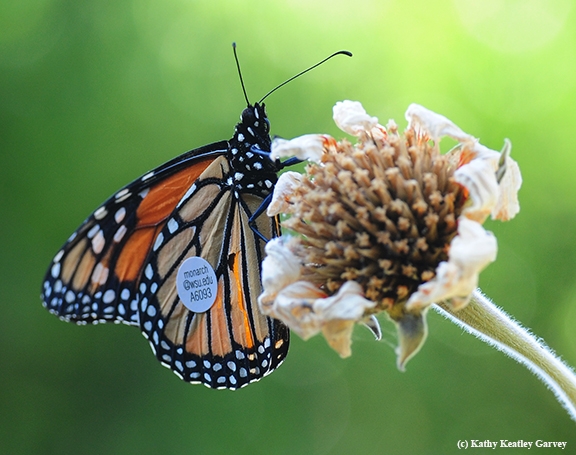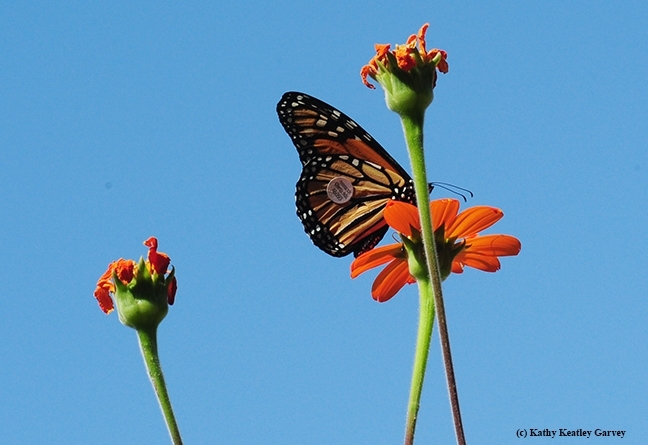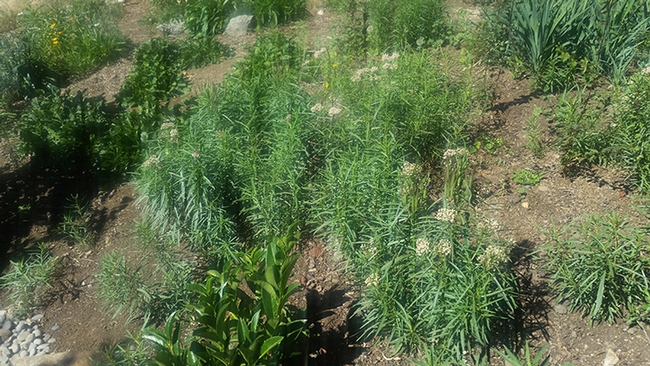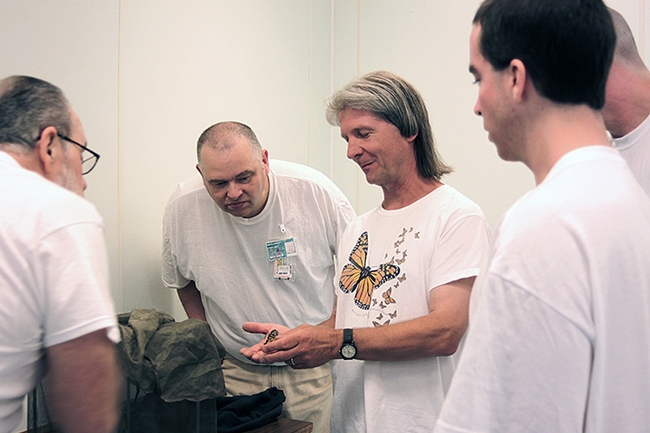
But at least we know he hails from Ashland.
That's what we learned about the male monarch that fluttered into our pollinator garden in Vacaville, Calif. on Monday, Sept. 5 (Labor Day) on his way to an overwintering site along the California coast.
The tag read "monarch@wsu.edu," and serial number "A6093," which ties the butterfly to a research project led by Washington State University entomologist David James. He maintains a network of Pacific Northwest citizen scientists who rear, tag and release monarchs.
When I wrote a Bug Squad blog on Oct. 17, 2014 about James' work, encouraging folks to be on the lookout for WSU-tagged monarchs, I figured I'd never see one. Not me. Not ever. And then it happened. A6093 dropped down for some flight fuel.
His presence was pure serendipity for several reasons: (1) I had earlier written about James' work; (2) I'm a WSU grad--"Go Cougars!" and (3) I rear monarchs for conservation purposes (40 so far this season).
So, on Labor Day, I happened to be hanging out in our 600-square-foot pollinator garden, the ever-present camera strapped around my neck, when I spotted a white-tagged monarch 15 feet away. I edged closer (three feet and 10 inches, to be exact), and photographed serendipity.

It was a good day to hang out with a marvelous, magnificent monarch linked to my alma mater and an insect that matters. And I did.
The fellow that reared him was Steve Johnson of Ashland, Ore., a member of the Southern Oregon Monarchs Advocates (SOMA). He tagged him and released him on Sunday, Aug. 28. "So, assuming it didn't travel much on the day you saw it, it flew 285 miles in 7 days or about 40.7 miles per day," WSU entomologist David James told me on Sept. 6. "Pretty amazing. So, I doubt he broke his journey for much more than the five hours you watched him--he could be 100 miles further south by now. Clearly, this male is on his way to an overwintering colony and it's possible we may sight him again during the winter in Santa Cruz or Pacific Grove!”
What a traveler! Let's see, by car it's 410 miles from Ashland to the overwintering site of Santa Cruz. It's 451 miles from Ashland to Pacific Grove. And it's about 113 miles from Vacaville to Santa Cruz. I can get lost in a five-mile range.
After posting a Bug Squad blog on the migrating monarch, I received a delightful email from Steve Johnson, with the subject line “I am the tagger!”
Omigosh! The tagger!
“I am so glad that my progeny, A6093, made it to Vacaville,” he began. “I have released about 80 monarchs thus far this season and have tagged about 30." This is his first year to tag. Some were raised from eggs while others were collected as caterpillars from native milkweed on a five-acre parcel outside of Ashland (a parcel that includes 2.5 acres of vineyards). Some were reared at his home in Ashland.

"Since that time, the population has exploded on the property. That fall, we found a large caterpillar in the vineyard and just put a fire pit screen over it to protect it. Well, it made its chrysalis on the screen and we moved it to our greenhouse since it was starting to get cool in October. After 21 days it eclosed and we released it at the very end of October. We seriously considered driving it to Redding because of the pending forecast for an early winter-type storm!”
Yes, "monarch parents" are dedicated!
So last year Steve and Laurel began collecting caterpillars from the five acres and rearing them in commercially available cages. And, with the seed they collected in her vineyards and gardens, they also planted showy milkweed (Asclepias speciosa) in large pots at his house in town. They released 85 monarchs last year.
This spring, he and Laurel planted more seed at his house in town, both in pots and in the ground. The old adage, "plant it and they will come," rang true. The monarchs came!
“Although the butterflies were not numerous, a few females loved to lay their eggs in the potted milkweed and we probably collected as many caterpillars/eggs on the 1/3 acre in town as we did on the five acres in the vineyard," Johnson related. "For some reason there are far fewer butterflies and caterpillars on the five acres this year as compared to last year. In fact, right now, we are only seeing occasional migrants nectaring on our butterfly wall. We had days where we would see 8-10 monarchs skittering about the vineyard and gardens but not close to what we had last year. In town, in addition, we planted heartleaf milkweed (Asclepias cordifolia) and despite its small size in the first year we collected a few caterpillars from this beautiful species.”
Give a lot of credit to the Southern Oregon Monarchs Advocates (SOMA), formed in 2014, and to its leader Tom Landis. Last year SOMA reared and released more than 2000 monarchs as part of the WSU project. "This year we're putting more emphasis on controlled rearing in schools and have over a half-dozen schools in northern California and southern Oregon participating," said Landis, who worked at a Forest Service nursery in Colorado and then served as an Extension agent for nurseries across the west. "My primary focus has been monarchs and milkweeds workshops (67 so far) and creating pollinator habitat with monarch way stations."
Meanwhile, WSU entomologist David James continues his monarch research. In his "Annual Project Progress Report for 2015: Developing an Understanding of Monarch Butterfly Breeding and Migration Biology in the Pacific Northwest," the associate professor wrote that "with assistance from inmates at the Washington State Penitentiary, a total of 1487 monarchs were reared, tagged and released from Walla Walla, Yakima and Prosser during August and September. An additional 1400 monarchs were reared and tagged by citizen science collaborators in Oregon, Idaho and Nevada. Nineteen fall migrants were tagged at Lower Crab Creek. Thus, a grand total of 2906 monarchs were tagged during late summer and fall 2015 in the Pacific Northwest. At the time of writing (February 2016), 16 tagged monarchs have been recovered at distances greater than 50 miles from the release location, mostly in overwintering colonies on the California coast. The longest distance traveled was 775 miles by 2 males released at Walla Walla and Pasco found in the same overwintering colony at Morro Bay, CA. "
His project goals and objectives are five-fold:
- To determine the phenology and ecology of monarch butterfly breeding in eastern Washington. ?
- To determine migration directions, routes and destinations used by summer and autumn monarch butterfly generations in the Pacific Northwest. ?
- To determine the environmental cues responsible for inducing reproductive dormancy and migratory behavior in Pacific Northwest monarch butterflies. ?
- To engage incarcerated citizens at the Washington State Penitentiary in scientific research with demonstrable social and educational benefits to themselves and the corrections community.
- To provide scientific information needed for development of effective and targeted nectar and host plant conservation strategies along monarch butterfly migration corridors
As for Steve Johnson, it's really a small world. The "Monarch Dad" is connected to UC Davis and the UC Agriculture and Natural Resources (UC ANR). His late father, Walter Johnson, a UC Davis grad, served as a UC Extension agent for 40 plus years in Alameda, Placer and Shasta counties. A brother and two nephews are also UC Davis grads.
As for A6093, we're all wondering where he is now. Johnson quipped that maybe the monarch needs a name instead of a number. Maybe the name of a vineyard? It's possible A6093 came from an egg or a caterpillar in a vineyard that Banke leased to Eliana Wines. "The owner has a small tasting room on the property (on Gaerky Creek Road) where the tasters can sit out and watch the monarchs," Johnson noted. The owner, determined to evoke the elegance of the wine, named his wine Eliana, which in Hebrew and Romance languages means "God has answered."
This is for certain: A6093 was born in Ashland: either in town or in a vineyard just outside of town. He was tagged and released from town.
Meanwhile, keep an eye open for WSU-tagged monarchs. Their migration will continue through Northern California to coastal California until the end of October, James said. Then in February, the monarchs will leave their overwintering sites and head inland.
Let's hope that A6093 or Eliana will be one of them.
Attached Images:

This migratory monarch, released Aug. 28 from Ashland, Ore. and tagged with monarch@wsu.edu A6093, nectared on Mexican sunflower in Vacaville, Calif. on Sept. 5. (Photo by Kathy Keatley Garvey)

This is the vineyard in Ashland where A6093 may have originated. (Photo by Kathy Keatley Garvey)

WSU entomologist David James, wearing a monarch t-shirt, with citizen-scientist inmates at Washington State Penitentiary, Walla Walla. (Photo courtesy of WSU)